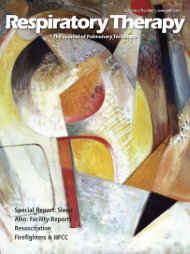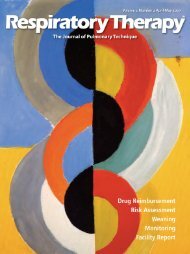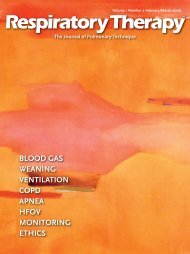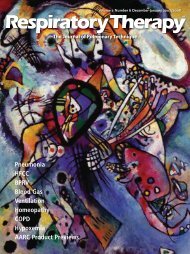RT 02-03 JJ07 main web - Respiratory Therapy Website
RT 02-03 JJ07 main web - Respiratory Therapy Website
RT 02-03 JJ07 main web - Respiratory Therapy Website
You also want an ePaper? Increase the reach of your titles
YUMPU automatically turns print PDFs into web optimized ePapers that Google loves.
What is the most exciting technology advancement that<br />
you foresee in the future (near and long term)?<br />
Among the short term advancements are expanded test menus,<br />
further automation, and reduced labor requirements. Long term<br />
we foresee the advent of continuous and less invasive<br />
technology.<br />
Opti Medical Systems<br />
Gerri Priest<br />
Gerri Priest is VP, Global Marketing, OPTI Medical Systems (formerly AVL).<br />
Blood gas analyzers have evolved over the past years to<br />
incorporate easier to use graphic user interfaces, reagent packs,<br />
<strong>main</strong>tenance-free sensors and on-board automatic quality<br />
control in response to the market’s needs that resulted from<br />
reduced technical staffing and the increased movement of<br />
critical care testing to the point of care. Recently, the automatic<br />
quality control feature has evolved a step further to incorporate<br />
sophisticated analyzer monitoring with automated corrective<br />
action and subsequent quality control material analyzed as<br />
needed.<br />
OPTI Medical Systems (formerly AVL) has implemented such an<br />
innovative monitoring system called OQM (OPTI Quality<br />
Monitor) in their latest OPTI product, the OPTI R Blood Gas<br />
Analyzer. OQM is an arrangement of sensors and software that<br />
continuously monitor the performance of the OPTI R. This is<br />
performed through data analysis and corrective actions. As the<br />
OPTI R is performing calibrations and automatic quality control<br />
the OQM software is observing the recovered values and sensor<br />
behavior by comparing the run to the previous results and then<br />
by looking at the sensor response. If the system detects an<br />
error it will perform corrective actions to correct the error<br />
detected. If the error is severe and the system cannot repair it,<br />
the sensor effected will be disabled. Measurements can still be<br />
performed but the disabled parameter cannot be reported.<br />
When errors occur that result in a disabled sensor the root<br />
cause of the failure is detailed in the error report.<br />
The OPTI R fluid pack contains three levels of QC solution that<br />
are independent from calibration solutions. All OPTI R fluid<br />
packs contain quality control solutions for use in the OQM<br />
system. This allows all users to take advantage of automatic QC<br />
without additional costs. The automatic QC program can be<br />
tailored to meet the needs of any user, with the possibility to<br />
program up to 15 QC measurements per day; even the most<br />
stringent guidelines can be met. The system can also be<br />
configured to skip automated QC measurements on Saturdays<br />
and Sundays if the facility is only in operation 5 days a week.<br />
When configuring the system to perform multiple levels at a<br />
single time, the OPTI R will schedule the samples to be run<br />
consecutively with a 1 minute pause between samples. This<br />
pause time allows for a STAT sample to be run during the<br />
automatic QC program.<br />
The OPTI R performs 50 patient samples in a single sensor<br />
cartridge in addition to the automatic quality control<br />
measurements programmed by the user and initiated by the<br />
OQM system.<br />
Advances in blood gas systems, such as OQM, have further<br />
facilitated the movement of blood gas analysis out of the <strong>main</strong><br />
lab to the point of care for improved turn-around times and thus<br />
more efficient patient care while still <strong>main</strong>taining high standards<br />
of measurement and manager control.<br />
24 <strong>Respiratory</strong> <strong>Therapy</strong> Vol. 2 No. 3 � June-July 2007











